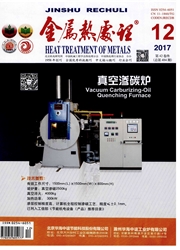

 中文摘要:
中文摘要:
采用分离式Hopkinson压杆(SHPB)装置进行了动态冲击试验,获得了名义应变速率为3500s^-1条件下2519A铝合金T87态、淬火态以及T87态与淬火态组合试样的真应力-应变曲线。通过对应力-应变曲线进行面积积分获得了试样单位体积吸收的动能值,用以比较不同处理状态试样的动能吸收能力。采用54式穿甲燃烧弹对20mm+20mm复合装甲板进行实弹打靶试验,以验证2519A铝合金动能吸收能力与抗弹性能的一致性,并运用TEM对侵彻弹坑边缘微结构特征进行分析。结果表明,2519A-T87态动能吸收能力最强,T87态与淬火态组合试样次之,淬火态试样最弱,打靶试验表明2519A合金的动能吸收能力与抗弹性能一致。
 英文摘要:
英文摘要:
The true stress-strain curves of 2519A aluminum alloy as T87, quenched and the combination of T87 and asquenched were obtained with the dynamic impact test at the nominal strain rate of 3500 s- 1 by split Hopkinson pressure bar(SHPB) setup. To compare the kinetic energy absorbing capacity of the different treated specimens, kinetic energy absorbing capacity per volume specimen was achieved by integrating the true stress-strain curves. Penetrating test through 2519A alloy multi-plates 20 mm + 20 mm in thickness with 54 armor-piercing incendiary was performed to con- firm the coherence between kinetic energy-absorbing capacity per volume 2519A alloy specimen and ballistic property of the alloy armor. The microstructures on the edge of crater were investigated by TEM. The results show that the kinetic energy absorbing capacity per volume of the alloy as the combination of T87 and as-quenched is better than as quenched alloy and that of T87 alloy is the best. Penetrating test shows the coherence between the kinetic energy absorbing capacity per volume 2519A alloy and the ballistic property of the alloy armor.
 同期刊论文项目
同期刊论文项目
 同项目期刊论文
同项目期刊论文
 期刊信息
期刊信息
